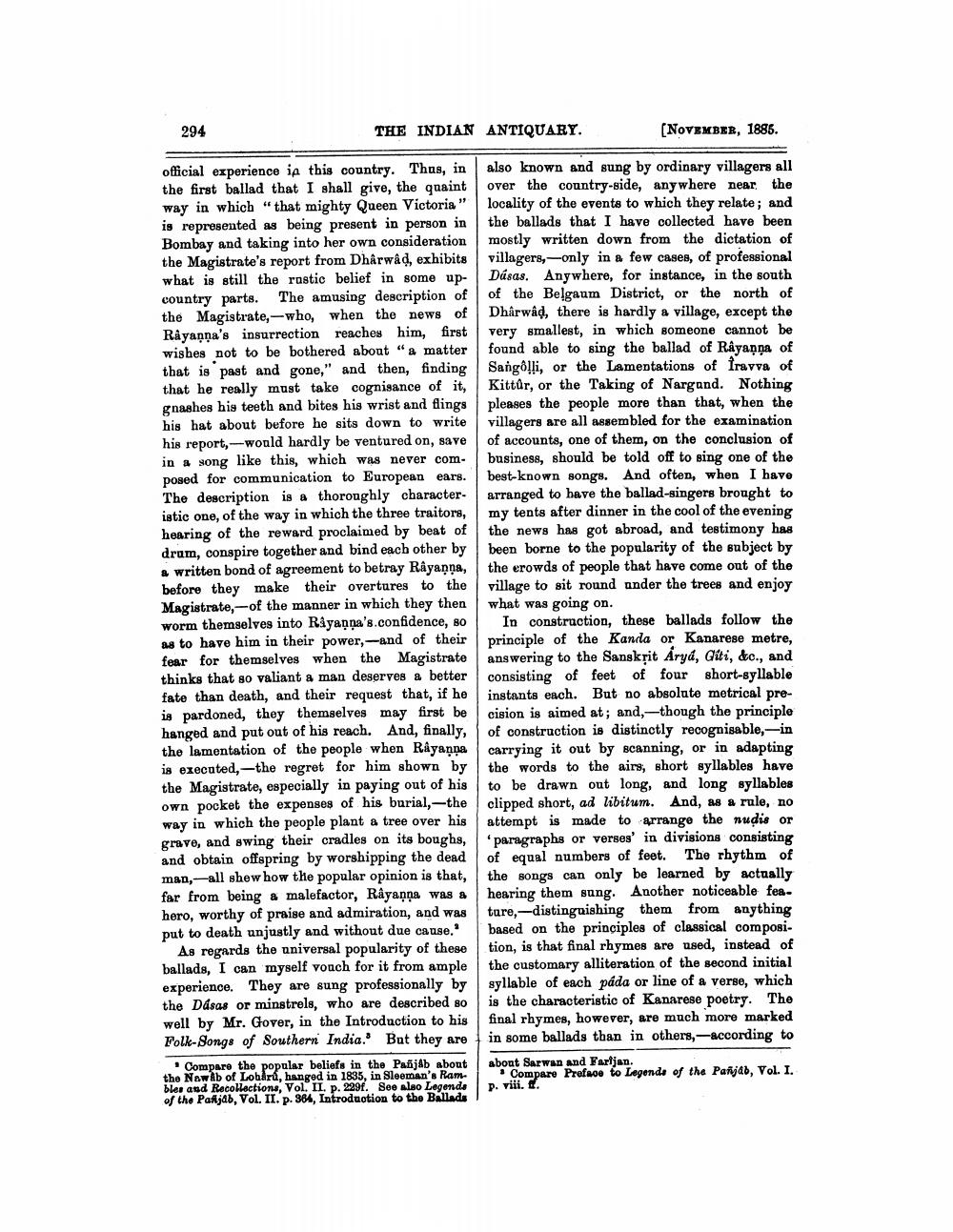________________
294
THE INDIAN ANTIQUARY.
official experience in this country. Thus, in the first ballad that I shall give, the quaint way in which "that mighty Queen Victoria" is represented as being present in person in Bombay and taking into her own consideration the Magistrate's report from Dharwad, exhibits what is still the rustic belief in some upcountry parts. The amusing description of the Magistrate,-who, when the news of Rayanna's insurrection reaches him, first wishes not to be bothered about "a matter that is past and gone," and then, finding that he really must take cognisance of it, gnashes his teeth and bites his wrist and flings his hat about before he sits down to write his report, would hardly be ventured on, save in a song like this, which was never composed for communication to European ears. The description is a thoroughly characteristic one, of the way in which the three traitors, hearing of the reward proclaimed by beat of drum, conspire together and bind each other by a written bond of agreement to betray Râyanna, before they make their overtures to the Magistrate,-of the manner in which they then worm themselves into Rayanna's.confidence, so as to have him in their power,-and of their fear for themselves when the Magistrate thinks that so valiant a man deserves a better fate than death, and their request that, if he is pardoned, they themselves may first be hanged and put out of his reach. And, finally, the lamentation of the people when Rayanna is executed, the regret for him shown by the Magistrate, especially in paying out of his own pocket the expenses of his burial,-the way in which the people plant a tree over his grave, and swing their cradles on its boughs, and obtain offspring by worshipping the dead man, all shew how the popular opinion is that, far from being a malefactor, Rayanna was a hero, worthy of praise and admiration, and was put to death unjustly and without due cause."
As regards the universal popularity of these ballads, I can myself vouch for it from ample experience. They are sung professionally by the Dásas or minstrels, who are described so well by Mr. Gover, in the Introduction to his Folk-Songs of Southern India. But they are
[NOVEMBER, 1885.
also known and sung by ordinary villagers all over the country-side, anywhere near the locality of the events to which they relate; and the ballads that I have collected have been mostly written down from the dictation of villagers,-only in a few cases, of professional Dúsas. Anywhere, for instance, in the south of the Belgaum District, or the north of Dharwad, there is hardly a village, except the very smallest, in which someone cannot be found able to sing the ballad of Rayanna of Sangolli, or the Lamentations of Iravva of Kittûr, or the Taking of Nargand. Nothing pleases the people more than that, when the villagers are all assembled for the examination of accounts, one of them, on the conclusion of business, should be told off to sing one of the best-known songs. And often, when I have arranged to have the ballad-singers brought to my tents after dinner in the cool of the evening the news has got abroad, and testimony has been borne to the popularity of the subject by the crowds of people that have come out of the village to sit round under the trees and enjoy what was going on.
In construction, these ballads follow the principle of the Kanda or Kanarese metre, answering to the Sanskrit Arya, Giti, &c., and consisting of feet of four short-syllable instants each. But no absolute metrical precision is aimed at; and, though the principle of construction is distinctly recognisable,-in carrying it out by scanning, or in adapting the words to the airs, short syllables have to be drawn out long, and long syllables clipped short, ad libitum. And, as a rule, no attempt is made to arrange the nudis or paragraphs or verses' in divisions consisting of equal numbers of feet. The rhythm of the songs can only be learned by actually hearing them sung. Another noticeable feature, distinguishing them from anything based on the principles of classical composition, is that final rhymes are used, instead of the customary alliteration of the second initial syllable of each pada or line of a verse, which is the characteristic of Kanarese poetry. The final rhymes, however, are much more marked in some ballads than in others,-according to
Compare the popular beliefs in the Pañjab about the Nawab of Lohard, hanged in 1835, in Sleeman's Rambles and Recollections, Vol. II. p. 229f. See also Legends of the Panjab, Vol. II. p. 364, Introduction to the Ballads
about Sarwan and Farljan.
Compare Preface to Legends of the Panjab, Vol. I. p. viii. f.




